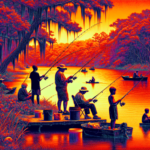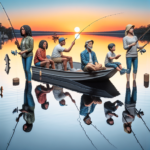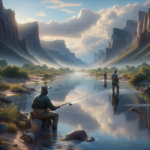Fishing in the Apalachicola River: Florida’s Best Fishing Spots

Introduction
Did you know that the Apalachicola River in Florida is home to some of the most diverse and abundant fishing opportunities in the southeastern United States? Whether you’re an experienced angler or a novice looking to cast your first line, the Apalachicola River offers a unique fishing experience that is hard to match. This article will guide you through the best fishing spots along the river, the techniques to use, the species you can expect to catch, and much more.
Fishing in the Apalachicola River is not just about the thrill of the catch; it’s about immersing yourself in a rich ecosystem teeming with life. From the historical significance of the river to the modern-day fishing techniques, this guide will provide you with all the information you need to make your fishing trip a success.
Background/Context
Historical or Cultural Significance
The Apalachicola River has a storied history that dates back to the Native American tribes who first inhabited the region. The river has long been a vital resource for transportation, trade, and sustenance. In the 19th century, it became a crucial waterway for the timber and cotton industries. Today, it remains an essential part of Florida’s natural heritage, offering a sanctuary for wildlife and a haven for anglers.
Geographical Overview
The Apalachicola River flows for approximately 112 miles from the confluence of the Chattahoochee and Flint rivers in Georgia to the Gulf of Mexico. The river’s basin encompasses a diverse range of ecosystems, including swamps, marshes, and estuaries. The climate is generally warm and humid, making it an ideal environment for a variety of fish species. The river’s topography includes deep channels, shallow flats, and numerous tributaries, providing a multitude of fishing opportunities.
Key Points/Details
Fishing Techniques
Technique Overview
Several fishing techniques are effective in the Apalachicola River, including fly fishing, baitcasting, and trolling. Each technique has its own set of advantages and is suited to different conditions and species.
When and Where to Use
Fly fishing is particularly effective in the river’s shallow flats and estuaries, where you can target species like redfish and speckled trout. Baitcasting is ideal for deeper channels and around structures like fallen trees and submerged rocks, where bass and catfish are commonly found. Trolling is best used in the river’s wider sections and during the cooler months when fish are more active.
Recommended Gear
- Fly Fishing: A 9-foot, 8-weight fly rod with a matching reel and floating line. Use streamers and shrimp patterns for best results.
- Baitcasting: A medium-heavy baitcasting rod with a high-speed reel. Use soft plastics, crankbaits, and spinnerbaits.
- Trolling: A heavy-duty trolling rod with a conventional reel. Use deep-diving plugs and spoons.
Species Information
Species Overview
The Apalachicola River is home to a wide variety of fish species, including largemouth bass, catfish, redfish, speckled trout, and striped bass. Each species has its own unique habits and preferred habitats.
Best Practices
For largemouth bass, focus on early morning and late afternoon hours, using topwater lures and soft plastics. Catfish are best targeted at night using cut bait or stink bait. Redfish and speckled trout are most active in the estuaries and can be caught using live shrimp or artificial lures. Striped bass are often found in deeper channels and are best caught using live bait or large crankbaits.
Location Information
Top Fishing Spots
- Apalachicola Bay: Known for its rich estuarine environment, this area is excellent for redfish and speckled trout.
- Lake Seminole: Located at the confluence of the Chattahoochee and Flint rivers, this lake is a hotspot for largemouth bass and catfish.
- St. Vincent Island: Accessible by boat, this island offers pristine fishing conditions for a variety of species.
- Fort Gadsden: A historical site with excellent shore fishing opportunities for bass and bream.
Regulations and Licenses
Fishing in the Apalachicola River requires a valid Florida fishing license. Regulations vary by species and location, so it’s essential to check the Florida Fish and Wildlife Conservation Commission’s website for the most up-to-date information. Common regulations include size and bag limits, as well as seasonal restrictions.
Seasonal Considerations
Seasonal Variations
Fishing conditions in the Apalachicola River change throughout the year. Spring and fall are generally the best seasons for fishing, as water temperatures are moderate and fish are more active. Summer can be challenging due to high temperatures and increased boat traffic, while winter offers excellent opportunities for targeting striped bass and catfish.
Best Times to Fish
The optimal times to fish are early morning and late afternoon, regardless of the season. During these times, fish are more likely to be feeding and less wary of anglers. Night fishing can also be productive, especially for catfish and striped bass.
Events and Tournaments
Event Overview
The Apalachicola River hosts several fishing tournaments throughout the year, including the Apalachicola Bay Chamber of Commerce’s annual Redfish and Speckled Trout Tournament. These events attract anglers from all over the region and offer substantial prizes.
Preparation Tips
To prepare for a tournament, make sure your gear is in top condition and familiarize yourself with the tournament rules. Pre-fishing the area can give you a significant advantage, as it allows you to identify productive spots and refine your techniques. Bring plenty of water, snacks, and sunscreen to stay comfortable throughout the event.
Tips and Best Practices
General Tips
- Always check the weather forecast before heading out.
- Use polarized sunglasses to spot fish and underwater structures.
- Keep your tackle organized and easily accessible.
- Practice catch and release to help preserve fish populations.
Avoid Common Mistakes
- Don’t overlook the importance of stealth; fish can be easily spooked.
- Avoid using overly heavy tackle, as it can reduce your chances of a successful catch.
- Don’t ignore local advice; local anglers often have valuable insights.
Advanced Techniques
- Master the art of “match the hatch” by using lures that mimic local baitfish.
- Learn to read the water to identify potential fish-holding areas.
- Experiment with different retrieval speeds and patterns to trigger strikes.
Gear and Equipment Recommendations
Essential Gear
- Rod and reel appropriate for your chosen technique.
- Quality fishing line (monofilament, fluorocarbon, or braided).
- A variety of lures and baits.
- Polarized sunglasses.
- Tackle box with essential tools (pliers, line cutters, etc.).
Optional Gear/Upgrades
- Fish finder or depth sounder.
- Kayak or small boat for accessing remote areas.
- High-quality waders for fly fishing.
- Waterproof camera for capturing your catches.
Where to Buy or Rent
Local shops like Fisherman’s Choice in Eastpoint and Apalachicola Ace Hardware offer a wide range of fishing gear and equipment. Online retailers like Bass Pro Shops and Cabela’s also provide extensive selections. For rentals, check with local marinas and outfitters.
Safety and Conservation
Safety Tips
- Always wear a life jacket when on the water.
- Be aware of local wildlife, including alligators and snakes.
- Stay hydrated and protect yourself from the sun.
- Inform someone of your fishing plans and expected return time.
Conservation Practices
- Practice catch and release whenever possible.
- Respect local wildlife and their habitats.
- Follow all fishing regulations and guidelines.
- Dispose of trash and fishing line properly to protect the environment.
Planning Your Trip
Accommodations
There are several lodging options near the Apalachicola River, ranging from cozy bed-and-breakfasts to modern hotels. The Gibson Inn in Apalachicola offers historic charm, while the Water Street Hotel & Marina provides waterfront views and convenient boat access.
Travel Tips
The Apalachicola River is accessible by car via U.S. Highway 98. The nearest major airport is Tallahassee International Airport, approximately 75 miles away. Renting a car is recommended for exploring the area and accessing various fishing spots.
Additional Activities
When you’re not fishing, explore the rich history and culture of Apalachicola. Visit the Apalachicola National Estuarine Research Reserve, tour historic homes, or enjoy fresh seafood at one of the local restaurants. The area also offers opportunities for kayaking, birdwatching, and hiking.
Frequently Asked Questions (FAQs)
Do I need a fishing license to fish in the Apalachicola River?
Yes, a valid Florida fishing license is required. You can purchase one online or at local retailers.
What is the best time of year to fish in the Apalachicola River?
Spring and fall are generally the best seasons for fishing, but each season offers unique opportunities.
Can I rent fishing gear locally?
Yes, several local shops and marinas offer gear rentals. It’s a good idea to call ahead to check availability.
Are there any fishing tournaments in the area?
Yes, the Apalachicola River hosts several fishing tournaments throughout the year. Check local event calendars for details.
Conclusion
The Apalachicola River offers a diverse and rewarding fishing experience for anglers of all skill levels. From its rich history and vibrant ecosystem to its variety of fish species and prime fishing spots, this river is a true gem for fishing enthusiasts. By following the tips and recommendations in this guide, you’ll be well-prepared to make the most of your fishing adventure in the Apalachicola River. So grab your gear, head to the river, and enjoy the thrill of the catch!




